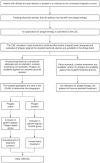Bacteriophage Therapy for Difficult-to-Treat Infections: The Implementation of a Multidisciplinary Phage Task Force (The PHAGEFORCE Study Protocol)
- PMID: 34452408
- PMCID: PMC8402896
- DOI: 10.3390/v13081543
Bacteriophage Therapy for Difficult-to-Treat Infections: The Implementation of a Multidisciplinary Phage Task Force (The PHAGEFORCE Study Protocol)
Abstract
In times where only a few novel antibiotics are to be expected, antimicrobial resistance remains an expanding global health threat. In case of chronic infections caused by therapy-resistant pathogens, physicians have limited therapeutic options, which are often associated with detrimental consequences for the patient. This has resulted in a renewed interest in alternative strategies, such as bacteriophage (phage) therapy. However, there are still important hurdles that currently impede the more widespread implementation of phage therapy in clinical practice. First, the limited number of good-quality case series and clinical trials have failed to show the optimal application protocol in terms of route of administration, frequency of administration, treatment duration and phage titer. Second, there is limited information on the systemic effects of phage therapy. Finally, in the past, phage therapy has been applied intuitively in terms of the selection of phages and their combination as parts of phage cocktails. This has led to an enormous heterogeneity in previously published studies, resulting in a lack of reliable safety and efficacy data for phage therapy. We hereby present a study protocol that addresses these scientific hurdles using a multidisciplinary approach, bringing together the experience of clinical, pharmaceutical and molecular microbiology experts.
Keywords: bacteriophage therapy; difficult-to-treat infections; efficacy; patient registry; safety.
Conflict of interest statement
The funders had no role in the design of the study; in the collection, analyses, or interpretation of data; in the writing of the manuscript, or in the decision to publish the results.
Figures


Similar articles
-
Bacteriophage Application for Difficult-to-treat Musculoskeletal Infections: Development of a Standardized Multidisciplinary Treatment Protocol.Viruses. 2019 Sep 23;11(10):891. doi: 10.3390/v11100891. Viruses. 2019. PMID: 31548497 Free PMC article.
-
Optimization of bacteriophage therapy for difficult-to-treat musculoskeletal infections: a bench-to-bedside perspective.Front Cell Infect Microbiol. 2024 Sep 3;14:1434397. doi: 10.3389/fcimb.2024.1434397. eCollection 2024. Front Cell Infect Microbiol. 2024. PMID: 39290977 Free PMC article.
-
Formulation, stabilisation and encapsulation of bacteriophage for phage therapy.Adv Colloid Interface Sci. 2017 Nov;249:100-133. doi: 10.1016/j.cis.2017.05.014. Epub 2017 May 14. Adv Colloid Interface Sci. 2017. PMID: 28688779 Review.
-
Phage Therapy in the Resistance Era: Where Do We Stand and Where Are We Going?Clin Ther. 2020 Sep;42(9):1659-1680. doi: 10.1016/j.clinthera.2020.07.014. Epub 2020 Aug 31. Clin Ther. 2020. PMID: 32883528 Review.
-
Bacteriophage therapy for multidrug-resistant infections: current technologies and therapeutic approaches.J Clin Invest. 2025 Mar 3;135(5):e187996. doi: 10.1172/JCI187996. J Clin Invest. 2025. PMID: 40026251 Free PMC article. Review.
Cited by
-
Isolation and Characterization of the Acadevirus Members BigMira and MidiMira Infecting a Highly Pathogenic Proteus mirabilis Strain.Microorganisms. 2023 Aug 23;11(9):2141. doi: 10.3390/microorganisms11092141. Microorganisms. 2023. PMID: 37763984 Free PMC article.
-
Bacteriophage therapy in musculoskeletal infections: from basic science to clinical application.EFORT Open Rev. 2024 May 10;9(5):339-348. doi: 10.1530/EOR-24-0042. EFORT Open Rev. 2024. PMID: 38726986 Free PMC article. Review.
-
Translating phage therapy into the clinic: Recent accomplishments but continuing challenges.PLoS Biol. 2023 May 23;21(5):e3002119. doi: 10.1371/journal.pbio.3002119. eCollection 2023 May. PLoS Biol. 2023. PMID: 37220114 Free PMC article.
-
Challenges and opportunities of phage therapy for Klebsiella pneumoniae infections.Appl Environ Microbiol. 2024 Oct 23;90(10):e0135324. doi: 10.1128/aem.01353-24. Epub 2024 Sep 30. Appl Environ Microbiol. 2024. PMID: 39345202 Free PMC article. Review.
-
Optimized preparation pipeline for emergency phage therapy against Pseudomonas aeruginosa at Yale University.Sci Rep. 2024 Feb 1;14(1):2657. doi: 10.1038/s41598-024-52192-3. Sci Rep. 2024. PMID: 38302552 Free PMC article.
References
-
- O’Neill J. Review on Antimicrobial Resistance. Wellcome Trust; London, UK: 2014. Antimicrobial resistance: Tackling a crisis for the health and wealth of nations.
-
- Tacconelli E., Carrara E., Savoldi A., Harbarth S., Mendelson M., Monnet D.L., Pulcini C., Kahlmeter G., Kluytmans J., Carmeli Y., et al. Discovery, research, and development of new antibiotics: The WHO priority list of antibiotic-resistant bacteria and tuberculosis. Lancet Infect. Dis. 2018;18:318–327. doi: 10.1016/S1473-3099(17)30753-3. - DOI - PubMed
-
- Onsea J., Wagemans J., Pirnay J.P., Di Luca M., Gonzalez-Moreno M., Lavigne R., Trampuz A., Moriarty T.F., Metsemakers W.J. Bacteriophage therapy as a treatment strategy for orthopaedic device-related infections: Where do we stand? Eur. Cells Mater. 2020;39:193–210. doi: 10.22203/eCM.v039a13. - DOI - PubMed
-
- WHO . Global Action Plan on Antimicrobial Resistance. WHO; Geneva, Switzerland: 2015.
Publication types
MeSH terms
LinkOut - more resources
Full Text Sources
Medical
Miscellaneous

